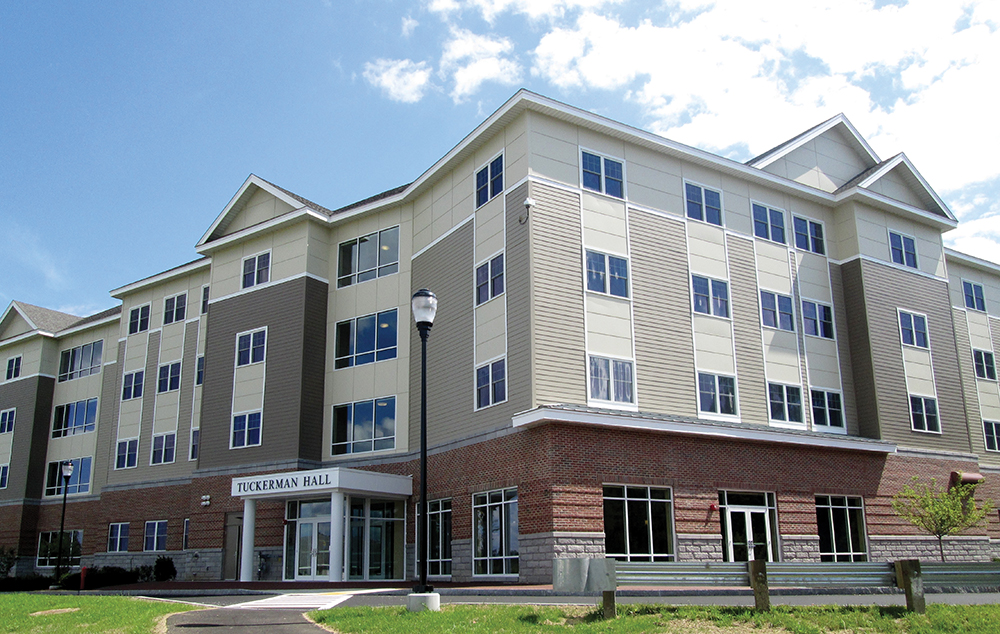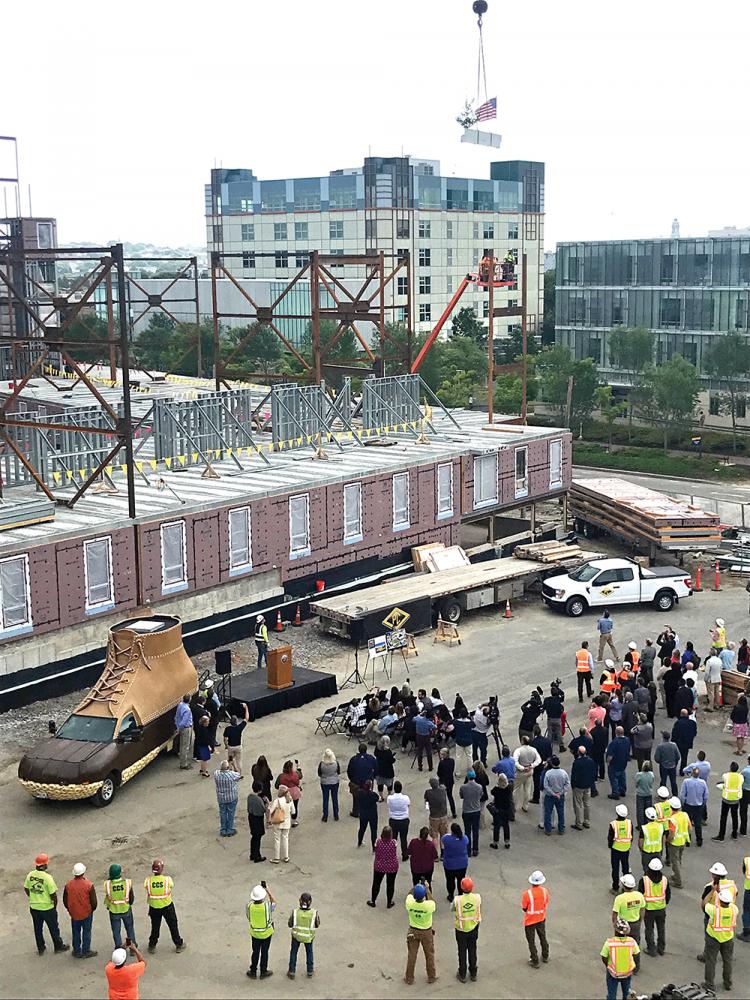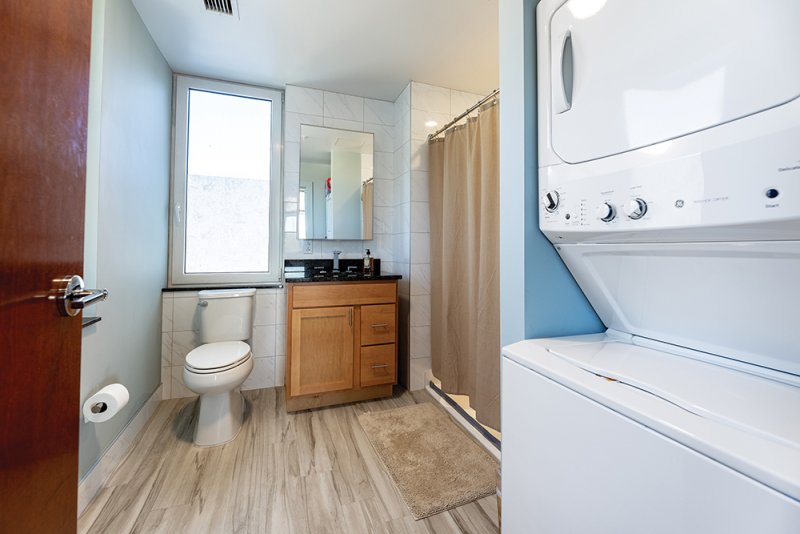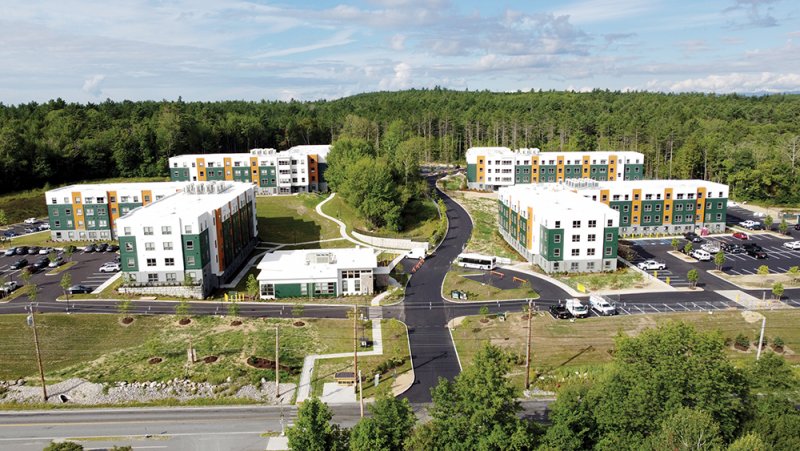 Tuckerman Hall at Southern NH University, built by North Branch Construction. (Courtesy photo)
Tuckerman Hall at Southern NH University, built by North Branch Construction. (Courtesy photo)
Often listed among the top in the country for their rural settings and old New England charm, NH college and university campuses may also come with inadequate student housing, cramped rooms, dated decor and a lack of basic amenities such as air conditioning and elevators.
As the state struggles with both a workforce shortage and a housing shortage, providing a positive college residential experience may improve the likelihood that students will stay in NH and have the added benefit of taking some pressure off nearby rental markets.
Building Boom
Over the past 10 years, many of the state’s higher education institutions have made significant improvements adding not only labs and learning centers, but reexamining dorm life and working with communities and developers to improve off-campus choices.
North Branch Construction in Concord built Tuckerman Hall, a four-story, 345-bed dorm at Southern NH University (SNHU) in Hooksett in 2013. “This was one of the first dormitories we constructed that had air conditioning with individual controls, which was pretty unusual at the time,” says Joe Campbell, president and director of business development at North Branch.
In Durham, home to the state’s flagship school, the University of NH, a 10-year construction boom in town has helped improve the rental market and brought harmony to the neighborhoods.
“Being the host to a major public research university has many positive attributes,” says Durham Town Admini-strator Todd Selig. “These folks will eat in our restaurants, coffee shops, participate in local events, serve as babysitters. But there are challenges when the lifestyle of the student body off campus, particularly late nights and weekends, differs from our year-round population.”
According to Selig, between 2000 and 2010, UNH expanded enrollment but was only housing between 40% to 45% of the students. Existing off-campus housing was inadequate and dated, much of it built in the 1960s or 70s. Selig says they started seeing students migrating farther out into traditional family neighborhoods.
“The property owners were not experienced student housing managers so they would rent a house with no lease or parameters on acceptable behavior and activities, and it would become a party house,” says Selig. “These properties were often physically deteriorated and rundown, with trash and bottles in the yard, broken glass on sidewalks and ever-increasing complaints. As it spread, entire neighborhoods began to transition.”
Young Drive was 1960s-era workforce housing, mostly duplexes, says Selig. “It became in essence a student ghetto; there were bonfires with hundreds of students gathering in the streets, cutting through the surrounding yards, passing out in flower beds.”
He says the town tried to address it and worked with the university, which increased housing capacity to about 50%. The town also started working with local landlords about establishing leasing agreements with clear expectations and consequences for damage and bad behavior.
Durham also changed its zoning to incentivize development of larger-scale student housing complexes to relieve the pressure from traditional neighborhoods, adding 2,500 to 3,000 student-focused beds. “Each major development was required to have 24/7 onsite management and clear lease agreements. We developed partnerships between these managers and our code enforcement office and in doing so, we turned the tide.”
In the opposite corner of the state, Dartmouth in Hanover has been experiencing growing pains of its own. The private, Ivy League institution has been renovating existing dorms for many years.
North Branch is currently building a $64 million, four-building, 628-bed graduate housing project that should be complete this fall. North Branch is also starting the renovation of Andres Hall and Zimmerman Hall for Dartmouth College, adding study areas, elevators and converting the rooms to mostly singles and doubles.
“When colleges build dormitories, it helps take the stress off the local market,” says Campbell. “This is going to have a huge impact on the market as all those students would be looking for apartments throughout Hanover and Lebanon.”
Focus on Amenities
Schools not only need to add capacity but to build the type of housing students are looking for, says Mike Leonard, a vice president and employee owner of PC Construction, which has NH offices in Manchester. He says they have constructed several student housing projects over the years and are currently working on a 580-bed project for the University of Southern Maine in Portland.

PC Construction working on a student housing project at the University of Southern Maine. (Courtesy photo)
“Schools are trying to keep kids on campus,” says Leonard. “But students don’t want residence halls anymore. Gone are the days of the little rooms, the double loaded corridor and roommates. You’ve got to provide something that’s more attractive, with a living room suite and a kitchen. That’s what’s generating this whole new housing look at the universities.”
Robert Duval, president, chief engineer and principal at TFMoran in Bedford and Portsmouth, which has completed projects at SNHU and St. Anselm College, agrees the needs and wants are changing.
TFMoran provided survey, permitting, civil/site engineering and landscape architecture for a four-story dormitory at SNHU that opened in 2017. It had amenities not typical for a college dorm at that time, such as a full kitchen, a living room and a separate shower from the bathroom. The building also had a fitness center, a game room and many common areas.

The fitness center in Monadnock Hall at Southern NH University. (Courtesy of TFMoran)
“The trend is toward individual baths,” says Duval. “They are expecting maid service and kitchenettes, with the overall feel trending more toward the look of multi-family housing.”
Such changes in amenities would also make it easier to convert student housing into general apartment rentals should student enrollment decline to the point that institutions do not require as much student housing.
Designs are also becoming specific to meet the unique needs of students and the requirements of their major. “Anytime you can build a project that serves a purpose it is always more fulfilling,” says Greg Stewart, president of Jewett Construction in Fremont. “Our White River Junction project was a high-end facility, not just a general spec apartment building. It was designed to accommodate the lifestyle of nursing students with laundry in every unit. It was a big expense for the developer but served a purpose.”

An apartment building in White River Junction, Vt., designed to accommodate nursing students. (Courtesy of TFMoran)
Community Pushback
Despite polling that shows NH residents support expanding housing opportunities, many communities struggle to approve multifamily projects. A public that says it supports more housing will often take a different view when it encroaches on
their neighborhood.
Dartmouth continues to engage the community in the North End Housing project. Plans call for three apartment-style residential buildings on Lyme Road with 128 apartment units, with capacity for about 400 undergraduate students or 300 graduate and professional students.
At a forum in July, abutters, many of them professors or Dartmouth graduates, shared their thoughts, suggesting the dormitory should be closer to the central campus. Several cited the well-being of students who they say would be better off within walking distance of the rest of the campus. A few admitted to speaking from a place of self-interest with concerns about the increased traffic.
At the start of the meeting, school officials made it clear the current site is where they plan to build and the capacity of 400 is necessary so that existing dorms, which haven’t been touched for 30 years, can be emptied and renovated.
Starting in 2019, Dartmouth created a master planning guide, with input from the community, for developing its physical campus over the next 30 years. According to a statement, the resulting “Planning for Possibilities: A Strategic Campus Framework” provided the foundation for long-term campus planning that includes the North End Housing project.

Dartmouth College graduate housing community. (Courtesy of North Branch Construction)
A similar dynamic is playing out in Durham. Selig says the Town Council established a housing task force, and while the community would embrace true market rate housing that is not for students, it is really hard to restrict it. “The most powerful dollar in a university town in terms of rental is the student dollar. They will outpay any other demographic to acquire the most desirable units closest to campus and downtown.”
The Mill Plaza project has been in the works for eight years and was rejected as “not in keeping with the surrounding neighborhood,” says Selig. “Because we host UNH, it changes the whole ethos of a community, attracting very well educated, engaged, passionate people who have the time to put into protecting what they value. When a developer does come forward, they encounter a highly engaged and very vocal opposition.”
